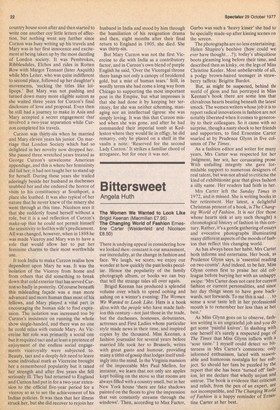Bittersweet
Angela Huth
The Women We Wanted to Look Like Brigid Keenan (Macmillan £7.95) The Changing World of Fashion Ernestine Carter (Weidenfeld and Nicolson £8.50) There is undying appeal in considering how we looked then: constant is our amazement, our incredulity, at the change in fashion and face. We laugh, we scorn, we enjoy our wonder at how quickly the past looks peculiar. Hence the popularity of the family photograph album, or books we can buy that tell the strange tales all over again.
Brigid Keenan has produced a splendid volume over which to spend oohing and aahing on a winter's evening: The Women We Wanted to Look Like. Hers is a book alive with the people who have made fashion this century — not just those in the trade, but the duchesses, hostesses, debutantes, actresses and First Ladies whose particular style made news in their time, and inspired copies by the thousand. Miss Keenan, a fashion journalist for several years before married life took her to Brussels, writes with great gusto and humour, providing many a titbit of gossip that lodges itself smilingly into the mind. In the Virginia mansion of the impeccable Mrs Paul Mellon, for instance, we learn that not only are apples kept boiling on the stove so that rooms are always filled with a country smell, but in her New York house 'there are fake shadows painted on the floors to give the impression that sun constantly streams through the windows'. Then, according to Max Factor, Garbo was such a 'heavy kisser' she had to be specially made-up after kissing scenes on the screen.
The photographs are no less entertaining: Helen Shapiro's beehive (how could we ever have thought.. .?); today's ubiquitiow boots gleaming long before their time, and described then as kinky, on the legs of Miss Christine Keeler. Most unbelievable of all, a podgy brown-haired teenager in strawberry taffeta: Brigitte Bardot.
But, as might be suspected, behind tit( world of gloss and fun portrayed in Miss Keenan's book there are some less that chivalrous hearts beating beneath the latest smock. The women writers whose job it is to report radical innovations in fashion are not notably liberated when it comes to generosity to their colleagues, So it came with no surprise, though a nasty shock to her friends and supporters, to find Ernestine Carter snarled at by Prudence Glynn in five columns of The Times.
As a fashion editor and writer for many years, Mrs Carter was respected for her judgment, her wit, her coruscating prose With unfailing integrity she gave formidable support to numerous designers of real talent, but was not afraid to criticise the kind of exhibitionist gear that gives fashion a silly name. Her readers had faith in her Mrs Carter left the Sunday Times in 1972, and is missed. She is writing books in her retirement. Her latest, a delightful Christmas present of a book, is The Changing World of Fashion, It is not (for those whose hearts sink at any such thought) a chronological history of fashion in this century. Rather, it's a gentle gathering of essays and evocative photographs illuminating many different aspects of the moods of fashion that reflect this changing world.
As has always been her habit, Mrs Carter both informs and entertains. Her book, as Prudence Glynn says, is 'essential reading on two counts'. And indeed, to be fair, Miss Glynn comes first to praise her old colleague before burying her with an unhappy swipe: 'Mrs Carter does not care for current fashion or current personalities, and since her day things seem to have gone backwards, not forwards. To me this is sad. . . to sense a sour taste left in her professional mouth is to remember her less than at her best.'
As Miss Glynn goes on to observe, fashion writing is an ungrateful job and you do get some 'painful knives'. In slashing with one herself it's surely a respected page of The Times that Miss Glynn inflicts with a 'sour taste.' I myself could detect no bitterness in Mrs Carter's comments: only informed enthusiasm, laded with reasonable and humorous nostalgia for her subject. So should her fans be puzzled by the report that she has been 'turned off' fashion, let me declare that wholly unjust and untrue. The book is evidence that criticism and relish, from the pen of an expert, are not incompatible, and The Changing World of Fashion is a happy reminder of Ernestine Carter at her best.


































 Previous page
Previous page